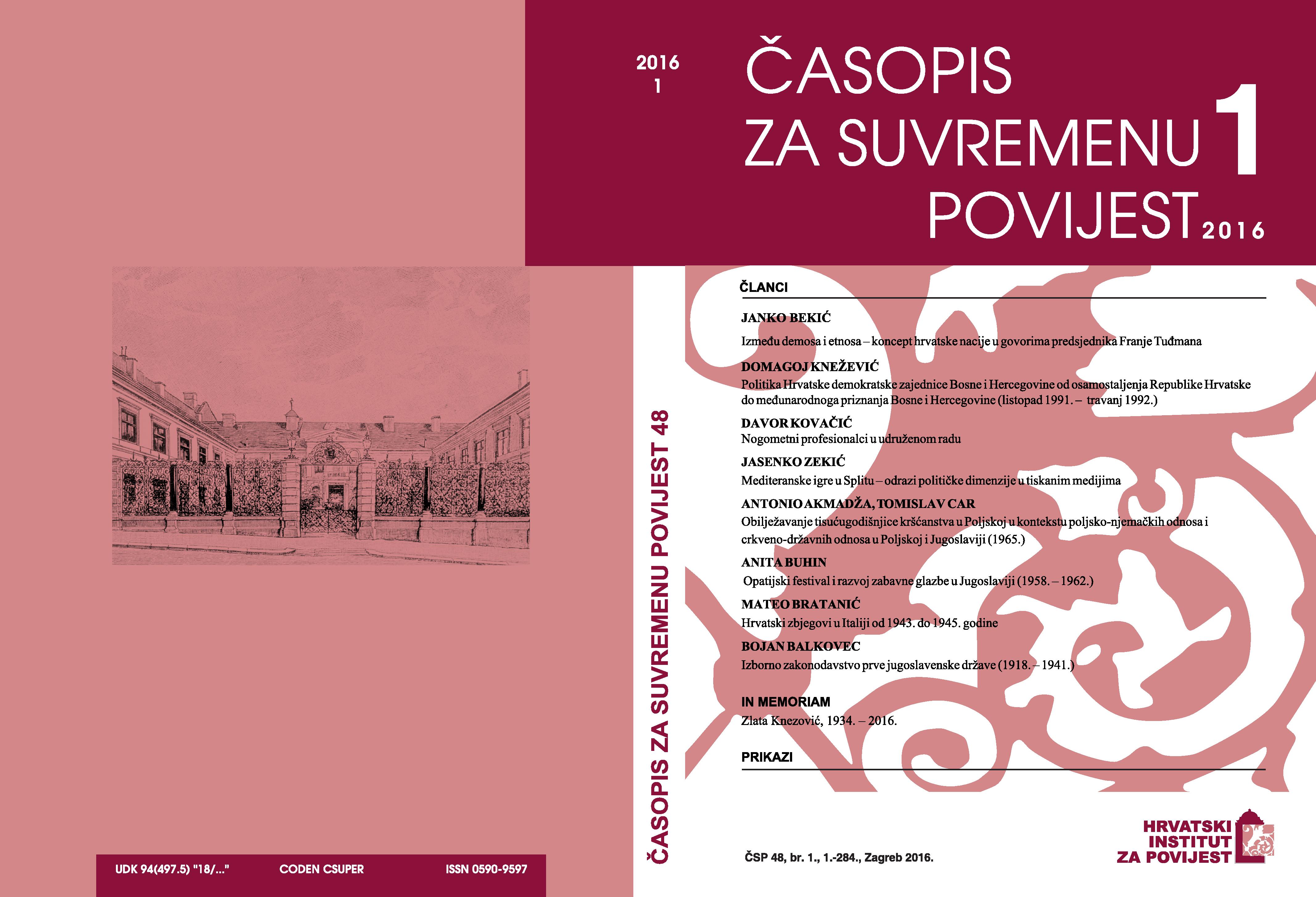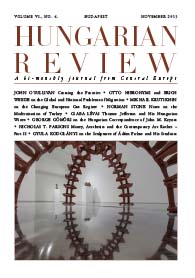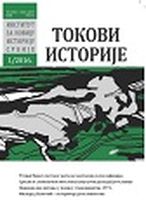
Around the Bloc: Pig Farm to Remain on Site of Wartime Czech Romani Camp
Farm site is regrettable, but we can’t afford to close it, Czech government says.
More...We kindly inform you that, as long as the subject affiliation of our 300.000+ articles is in progress, you might get unsufficient or no results on your third level or second level search. In this case, please broaden your search criteria.

Farm site is regrettable, but we can’t afford to close it, Czech government says.
More...
King Michael led Romania during the darkest days of its modern history, overcoming a controversial past to become a revered elder statesman.
More...
The history of Croatian refugees in Italy should be viewed as a stage in history of the Croatian refugee camps from 1943 to 1946. Italy is primarily important as an area which a large number of refugees from the territory ofsouthern Croatia went through, for most of them it was just a stop on a trip to Egypt, and for minority of them it was also a permanent residence till they return to their homeland. It is also significant as an area of the ongoing military cooperation between the partisan movement and the Western allies, a place where the most important operative segments of the Croatian refugee camps were set, where the relationship with the Western allies was elaborated, as well as the importance that the refugee camps could have had on the foreign territory. This minor part of Croatian refugees, which counted maximally up to 7000 people, witnessed the difficult conditions of everyday life in the Italian refugee camps. Impossible living conditions, insufficient clothing, inadequate nutrition and conflicts with the royalists were just some of the indicators of a hard life in the Italian camps. However, the most difficult circumstances were those of medical nature. Various diseases did not spare the members of the camps, especially children who were dying because of inadequate medical care. In addition to all these troubles, life in the camps continued, and it was filled with all sorts of activities in the social, labour, cultural and educational field that made waiting for a return to homeland quicker to pass. Activities of Croatian refugees in the Italian camps had continued until the return of the last group of camps’ members from Italy in March 1945. Within such relationships, activities of the refugee camps in Italy were simply a small sign of what was parallel happening in Egypt.
More...
It is instructive to compare Hitler and Churchill as boys in school. Churchill at St George’s School, Ascot (1884). Headmaster’s remarks. General conduct: “very – bad – is a constant trouble to everybody and is always in some scrape. He cannot be trusted to behave himself anywhere. He has very great abilities.”
More...
‘Anthropoid’ is most accurate film version yet of the Holocaust planner’s death and its bloody aftermath, producers say.
More...
Based on primary sources and relevant literature the paper analyzes the Italian propaganda campaign in Yugoslavia during 1938. The exhibition Italian Portrait through the Centuries held in the Prince Paul Museum in Belgrade and publication of a special issue of the newspaper Vreme were the most prominent examples. Within this propaganda action, group visits of Yugoslav ruling party sections, that were financed and organized by the fascist government, will be also discussed. The article aims to show how the visits were planed and organized, their development and achieved results.
More...
The Organisation of Yugoslav Nationalists (Orjuna) was established in the beginning of the 1920s in Dalmatia, from where it expanded to the other provinces of the Kingdom of SHS. This expansion was related to the activities of numerous refugees retreating from the Primorska (Littoral) region and Istria due to fascist persecution. Therefore Orjuna also organised propaganda, sabotage and general resistance in the Littoral region itself with the ultimate goal of liberating and annexing this region to its homeland. Naturally, espionage in favour of the Yugoslav Army also took place, which is why this organisation enjoyed the support of the Yugoslav authorities. However, this gradually changed due to its terrorist activities and inconveniences resulting from it, affecting the Yugoslav relations with Italy. It is obvious that Orjuna itself and its concrete activities in the Littoral region caught the interest of the Italian intelligence and diplomatic services. The Italian consulate in Ljubljana was especially active in this sense, making use of confidants among the Slovenian refugees. On the other hand Orjuna also organised its own spy network against the consulate, so that a kind of a spy war took place in Ljubljana. Through the embassy in Belgrade and Ministry of Foreign Affairs in Rome the reports about emigrants and members of Orjuna found their way into the police dossiers of the Ministry of the Interior in Rome. It is interesting that the systematic investigation of Orjuna and similar organisation by the leadership of the Italian police did not begin until as late as 1928, when Orjuna was already in decline. In his article the author addresses the main characteristics of Orjuna's activities, as reported by the fascist diplomatic and police bodies.
More...
Totalitarianism as a concept has come into use after 1923. At first it denoted the fascist movement in Italy, but later its meaning was extended to similar phenomena in other countries. Totality is supposed to describe the authorities not satisfied merely with controlling the political life in a country, but trying to penetrate all aspects of life and social subsystems, from economy to media, culture and sports, as well as interfering with the private realm, aiming to influence the way people think, make decisions, and act. The concept of totalitarianism came into scientific use after World War II, when Hannah Arendt published her work The Origins of Totalitarianism. In the following decades research under the influence of the Cold War took place, often focusing on comparing the Soviet Union under Stalin and after his death, in the time of de-Stalinisation. The question of which regimes could be described as totalitarian has been asked throughout the decades, and it once again became the subject of more attention in the expert discussions after the fall of the Berlin Wall and the end of the Cold War in the 1990s.
More...
The repression of the occupation authorities, aimed against the Slovenian population, was built into the very foundations of the occupation policy, especially German, since its goal was to ensure denationalisation and force population's loyalty to the occupying states. An even rougher and more severe form of repression was also used as the basic method in the anti-resistance activities of all three occupiers. Similar forms of repression (mass imprisonment, internment, violence against the population during cleansing operations, executions of resistance members without judicial proceedings, use of extreme and swift judicial proceedings) did not only affect those who took part in the resistance movement: they had many characteristics of an all-out punishment of the Slovenian population. The dimensions and effects of repression intensified by involving a part of the population in the fight against the resistance movement.
More...
The article focuses on the Nazi repression against the autochthonous Slovenian-speaking population in the Austrian Styria living near the Yugoslav border as well as against Slovenian immigrants in Graz and in other parts of Austrian Styria. On one hand this repression is described as a complex of criminal activities building on the proven German national tradition of national struggles dating back to the time before World War I. On the other hand the Nazi repression involved a new dimension of negative intensity, leading directly to an extensive denationalisation policy in Slovenia after 6 April 1941. Besides people living near the border, in the territory of Austrian Styria this repression was also aimed against persons who had contacts with Yugoslavia, officials of the Slovenian society Čitalnica in Graz, and every person of Slovenian origin taking part in the political resistance or cooperating with partisans.
More...
The author looks at a range of executions in the territory inhabited by Slovenians in the time of totalitarian regimes and especially during World War II. The executioners and victims could be found on both of the opposing sides we can, with some simplification, refer to as anti-fascists and fascists, partisans and occupiers (collaborators), communists and anti-communists. Then the author focuses on the memory of the victims of these executions. On one hand this memory is still very alive – for example, the memory of the four anti-fascists convicted at the 1st Trieste Trial of September 1930 and shot at Basovizza, who became the symbol of the anti-fascist resistance of the Slovenians from Primorska; and the memory of those who went missing after having been arrested by the Yugoslav authorities in Venezia Giulia in May 1945 and who are symbolised by the monument at the so-called Basovizza foiba. At the same time the post-war extrajudicial executions, ignored for a number of years, are now in the centre of attention, while the hostages who were killed or died in the fascist and Nazi concentration camps are disappearing from memory. Here the author underlines especially the culmination of violence caused by the German occupiers in the so-called Lower Styria in 1942.
More...
On the basis of archive materials, press and historiographic as well as other literature, the author describes the incidence and extent of repression against the German minority in Croatia, Bosnia and Herzegovina and Vojvodina at the end of World War II and in the first years after the war. In the end of 1944 and in the beginning of 1945 the partisan movement and the newly established people’s authorities of Yugoslavia started persecuting the so-called Volksdeutsche (ethnic Germans). The act of the Presidency of AVNOJ (Anti-Fascist Council of National Liberation of Yugoslavia), adopted on 21 November 1944, also contributed to this, as it declared the members of the German minority as collectively guilty. Subsequently most Volksdeutshe lost their citizen rights, their property was confiscated, while they themselves were interned in the camps and sentenced to years of forced labour. The authorities used the war crimes perpetrated by certain members of the German minority and their disloyalty during the occupation as a reason and excuse for the inhumane treatment of the Volksdeutsche towards the end of the war and immediately after it.
More...
The article focuses on the exodus from Zone B of the Free Trieste Territory in the context of the wider phenomenon of the exodus of the population of Venezia Giulia and Dalmatia and describes its essential characteristics. The author begins with the evolution of the term »exodus« itself. At first this was a militant expression, but gradually it turned into a general interpretative category, used to refer to a special type of forced relocation taking place in Europe, different from deportation and exile. Then the author analyses the main incentives resulting in the exodus, paying special attention to the policy of the »Slavic-Italian brotherhood« as a strategy of selective integration, as well as to the operations undertaken by the »people’s authorities«. Similar processes also took place in Zone B of the Free Territory of Trieste, even though there these processes lasted until as late as 1954 due to the uncertainty with regard to which state this territory would belong to. The author focuses mostly on the relations between the Italian population and the new authorities and touches upon certain topics of the most recent research. He also brings the attention to the still unfinished research with regard to the National Liberation Committee for Istria and radio station Radio Venezia Giulia. Finally he also focuses on the final stage of the Trieste question, concluded with the signature of the London Memorandum and followed by the emigration of almost all of the Italian population from Zone B of the Free Territory of Trieste and settlement of exiles in the Trieste territory.
More...
The article based on archive sources, literature and testimonies of internees describes the policy of the Hungarian authorities during World War II towards the colonists, settled near Dolnja Lendava by the Yugoslav-Hungarian border in the context of the Yugoslav agrarian reform. After the Prekmurje region had been annexed to Hungary in April of 1941, the authorities confiscated all of the agrarian land expropriated in the Kingdom of Yugoslavia in the context of the agrarian reform, so it became the property of the state. Thus the colonists lost their means of survival. After the negotiations between Hungary and Italy, where the colonists had originated from, with regard to the extradition of the colonists failed, in June 1942 the Hungarian authorities interned 587 colonists from the surroundings of Dolnja Lendava in the Sárvár internment camp. Soon after their arrival to the camp, the children younger than 16 were taken to Bačka, where they remained until the end of the war, while more than 50 colonists decided to leave to the Independent State of Croatia. During the internment, 35 of the colonists from the surroundings of Dolnja Lendava died.
More...
The article focuses on various phenomena and forms of repression carried out by the authorities of the communist Rákosi regime (especially State Security Service) in the triangle of borders in the Rába Valley, especially after the Cominform Resolution, when it was declared that Yugoslavia was an enemy. This resulted in »war hysteria« aimed against Tito, and the war preparations also involved a preventive »cleansing« of the area bordering on Yugoslavia. South Slavs (also Slovenians) became the potential enemies of the regime. One of the most efficient methods for the removal of persons unwanted by the government was deportation to closed work camps in the provinces of Hortobágy, Nagykunság and Hajdúság in the east of Hungary, operating between 1950 and 1953. The coercive measures taken by the authorities against the people include forced labour in the camps, police supervision, physical and psychological maltreatment of the internees, inhuman living conditions and so on. The author bases her presentation of the developments at the time on the relevant archive documents and testimonies of the internees who are still alive.
More...